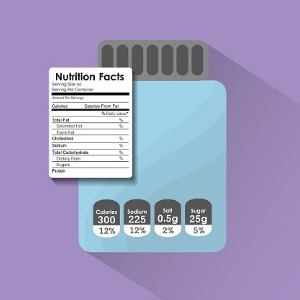
Packaged foods come with nutrition labels that give you vital information about your food. It’s important to familiarise yourself with food labels and take responsibility for what you put into your body.
Understanding labels
Sticking to a healthy diet is a good step in improving your overall health. But checking food labels takes your health journey to the next level as it helps you make informed health choices by comparing nutrient content.
Make sure you get enough beneficial nutrients like protein, dietary fibre, calcium, iron, vitamins, choline, magnesium and potassium.
Good to know:
- Calories: Provide a measure of how much energy you get from a serving of a specific food.
- Protein: Is one of the three nutrients used as energy sources (calories) by the body.
- Carbohydrate: Energy-providing nutrients. Carbs are separated into simple carbohydrates (sugar), complex carbohydrates (fibre) and starch.
- Fat: Supplies you with energy and helps nutrients do their jobs. Good fats are called “unsaturated fats” and bad fats are “saturated fats”.
- Sodium: Also known as salt; it’s an important compound to absorb and transport nutrients.
- Sugar: Sugar is a source of energy.
- Potassium: An essential mineral that helps regulate fluid balance, nerve signals and muscle contractions.
The power of 5
When reading the 100g column, remember the number five. If you're trying to cut saturated fat, eat fewer foods that have more than 5g of saturated fat per 100g.
Total fat
High: More than 17.5g of fat per 100g
Low: 3g of fat or less per 100g
Saturated fat
High: More than 5g of saturated fat per 100g
Low: 1.5g of saturated fat or less per 100g
Sugar
High: More than 22.5g of total sugars per 100g
Low: 5g of total sugars or less per 100g
Salt
High: More than 1.5g of salt per 100g (or 0.6g sodium)
Low: 0.3g of salt or less per 100g (or 0.1g sodium)
Spot the hidden culprits!
Watch out for fats, salt and sugar which can hide under different names. This information will help you stay on track with your health goals. It also enables you to avoid certain ingredients if you have a food intolerance or are following a diet that excludes certain components, like dairy, gluten or nuts.
Look for foods low in saturated and trans-fats, and cholesterol, to help reduce the risk of heart diseases. According to the American Heart Association, when the nutrition label says a food contains “0g” of trans-fat, but includes “partially hydrogenated oil”, it means the food contains some trans-fat, but less than 0.5 grams per serving. So, if you eat more than one serving, you could end up eating too much trans-fat.
If some form of sugar is in the first three ingredients, find a healthier alternative. Scale back on highly processed foods and buy whole foods instead. Cut back your sodium intake to less than 2 300 milligrams per day (about one teaspoon of salt) to reduce the risk of high blood pressure.





 Publications
Publications
 Partners
Partners










